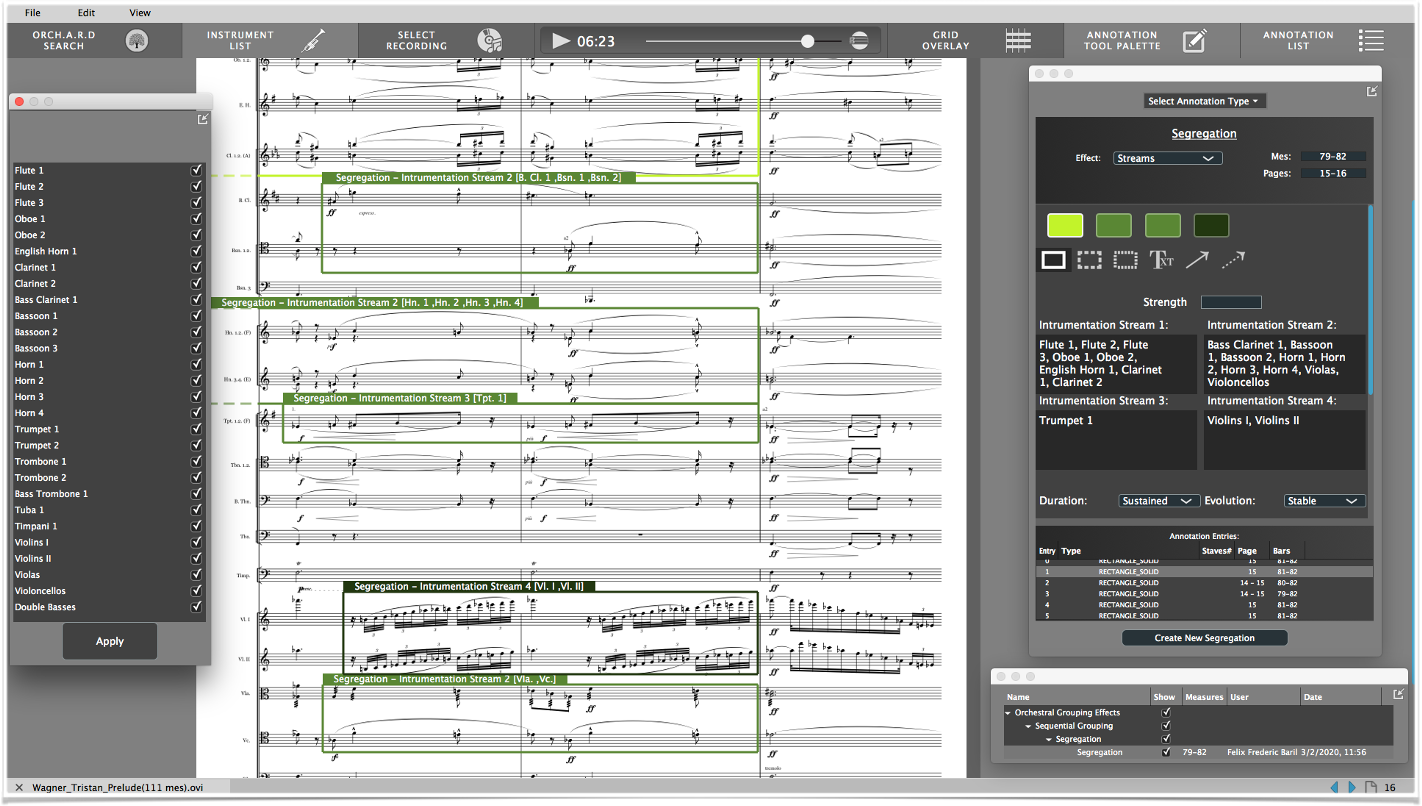EN | FR
OrchView
Summary | Contact info | Overview | Subgroups | Projects
Summary
This group focuses on the planning and development of the OrchView software which involves discussions on its functionalities and on the taxonomies, as well as their corresponding annotation tools (grouping effects and orchestration techniques).
Workgroup Leader
Félix Baril
Contact: felix.baril[at]mcgill.ca
Overview
OrchView is a software platform for score analysis.
It is the first software of its kind to offer features and tools specifically designed for orchestration analysis. OrchView includes annotation tools built for the orchestral grouping effects taxonomy. The orchestration techniques tools are currently being implemented and will be made available in 2021.
The data for each annotation is collected as a user progresses with their analysis. This includes the bar numbers, selected instruments, audio time-codes for the reference recording used in the analysis, tool used and tool parameters. OrchView annotations can be labelled, displayed or hidden. The resulting score including its annotations can be exported as a new PDF file. Once an annotation has been validated the data are then uploaded to the OrchARD database (add link if for web). From the OrchARD website researchers can make queries and search through thousands of OrchView annotations. The results will then be available to download as an OrchView file. It is then possible to listen to the recording at the precise location indicated in the score.
OrchView includes an optical score recognition algorithm which is able to detect staves and measures from imported PDF scores. Furthermore, a new MusicXML package format has been developed for OrchView in collaboration with OrchPlayMusic. This format will allow for data-mining features to be added in the coming years, such as automatic detection of couplings and octave doublings, modes of playing, dynamics and different visual representations of the score. Instruments and bars annotated in OrchView can immediately be heard in OrchPlay (add link if for web) - isolated from the rest of the orchestra - while OrchPlay scores may be opened in OrchView to be annotated.
With the planned integration of audio representations and improvements to its custom tools feature OrchView has the potential to become the main software platform for music analysis.
Orchestration can be analyzed from many perspectives—such as the taxonomy of orchestral grouping effects, orchestrational techniques, functions, or timbral associations, aural sonology, and more. The future vision for the OrchView software is to eventually install all these branches of analysis right into it—as well as harmonic and formal function analysis—and have it elucidate analytic co-relations.
The software therefore possesses an important pedagogical function: its platform creates the opportunity to see the annotated information where aural, symbolic, technical, and perceptual information all intersect and interact. By examining such interactions, let’s call them vectors of musical information, a music scholar will gain greater insight into the function of such co-related attributes
Subgroups
1. Development:
Subgroup leader: Félix Frédéric Baril
Design and Coordination: Félix Frédéric Baril
Programming: Baptiste Bohelay, Daimen Duncan
2. Orchestral Grouping Effects Tools:
Subgroup leader: Stephen McAdams
Stephen McAdams, Kit Soden, Meghan Goodchild
3. Orchestration Techniques Tools:
Subgroup leaders: Denys Bouliane, Félix Frédéric Baril
Denys Bouliane, Félix Frédéric Baril, Dominique Lafortune, Philippe Macnab-Séguin
4. XML and Music Entry:
Subgroup leaders: Philippe Macnab-Séguin
Philippe Macnab Séguin, Dominique Lafortune, Eulalie Emeriaud
Active or Envisioned Projects
1. Beta-testing of the perceptual grouping effects tools
2. Implementation of orchestration techniques tools
3. Development of aural sonology tools
4. Data flow integration with OrchARD
5. Interface with OrchPlayMusic Library
6. XML creation and importation protocol and scripts
7. Development of audio representations and visualizations
Connect
SLACK Channel
Contact Andre Martins de Oliveira if there are any issues accessing this Slack Channel



